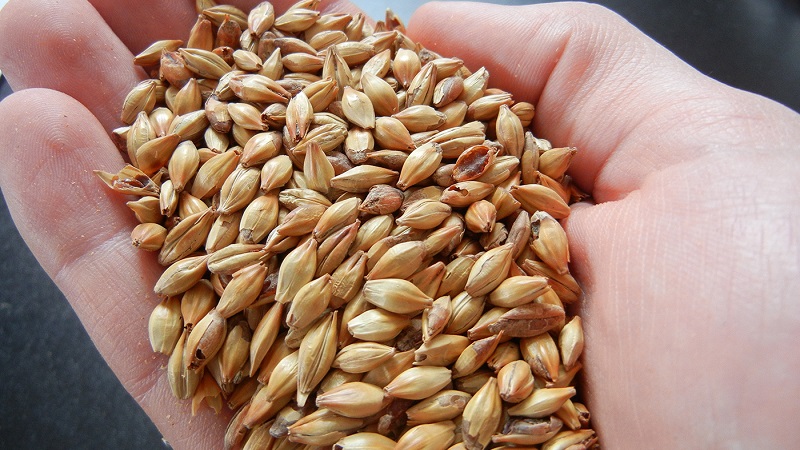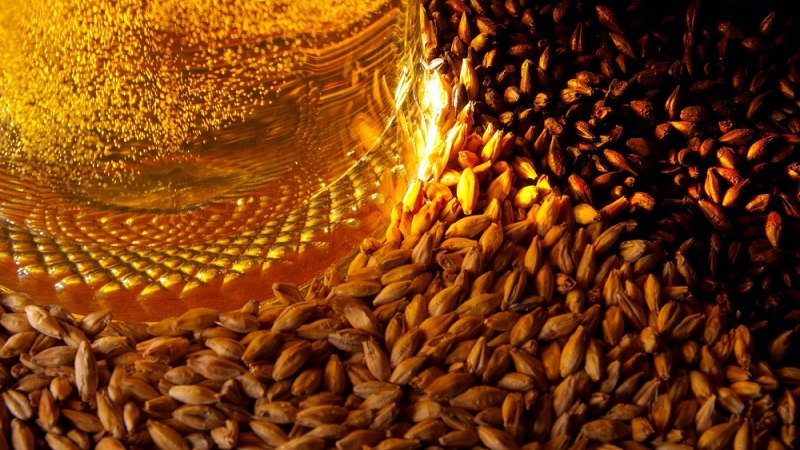Characteristics of malting barley
The taste, aroma and color of the beer depend on the quality of the malt. For the preparation of a hop drink, barley of certain varieties is used, for the breeding of each of which it takes breeders on average about 10 years. A special cultivation technology ensures optimal grain characteristics.
The content of the article
Composition and biological characteristics of malting barley
The plant belongs to the Cereals family. The caryopsis consists of an embryo, a mealy body and a shell. Main features of barley:
- Differs in high productivity, resistance to cold and heat... It is characterized by rapid growth and development. The most favorable for growing is a stable, gradually increasing temperature without sudden changes.
- Prefers loose soil with good aeration... An important criterion when choosing a site is soil uniformity. Sandy and sandy loam soils are unsuitable for most varieties: due to high water permeability, even a short-term drought will slow down the development of culture. Clay soil will not work either: it will not allow the root system to grow stronger. Peatlands and soils with high acidity are not chosen for cultivation.

Grains contain organic and inorganic compounds:
- Carbohydrates... Extremely important in brewing technology - they stimulate the formation of ethyl alcohol and the development of yeast.
- Starch (from 55 to 66%). With gradual heating, it becomes viscous; during hydrolysis, sugars are formed from starch.
- Cellulose... Its main amount is in the flower coat, and during malting it acts as a filtering layer.
- Pectin compounds... Increases foam formation in beer.
- Vitamin and mineral complexes... They play an important role in grain germination technology, during fermentation and yeast growth.
Barley contains polyphenols, fats, organic acids, ash elements... The main difference between brewing raw materials is a low protein content (no more than 12%).
Interesting on the site:
How to make barley malt at home
Qualitative characteristics
The varieties used in brewing are distinguished by their special malt properties... Thanks to easy processing, the yield of a quality product from a unit of raw materials increases.
Characteristics of brewing grain:
- The form... Under favorable growing conditions, the grains are oval or elliptical with rounded lateral edges.
- Colour... The color is uniform yellow of varying intensity. A greenish tint indicates insufficient maturity.
- Smell... The aroma is fresh, associated with straw.
One of the important characteristics is extractivity... This is the amount of dry matter that passes into solution after treatment. The optimal level is 78–80%.
Barley classification
According to agrotechnical characteristics, winter and spring barley are divided. Their main difference is the sowing time. Winter crops are sown from October to November, spring crops - from March to April. The timing depends on the climatic conditions of the region.
By the type of ears (morphological characteristics), barley is divided into two-row and six-row. Two-row ears give from 25 to 30 grains, six-row ears - from 30 to 60. The former are mainly used in brewing.
Barley varieties for beer
There are several hundred varieties of barley. In the regions of Russia, such (yield indicated per 1 ha):
 Scarlett... It is characterized by a loose ear, gives up to 65 centners.
Scarlett... It is characterized by a loose ear, gives up to 65 centners.- Gladis... One of the best varieties with strong immunity and lodging resistance. Productivity - about 98 centners.
- Donetsk 8... It has a loose ear with large grains. Resistant to lodging and drought. Productivity - 45 centners.
- Annabelle... Spikes of medium density with large grains. The variety is highly immune. Gives 40-50 centners of the harvest.
- Consita... Yields 40–88 centners of grain, resistant to root rot and head smut. The ears are of medium density, cylindrical in shape. The grain is large.
- Zazersky 85... Slightly drooping variety, gives 37–65 centners of grain.
- Gastinets... An early ripening variety with high brewing qualities. Productivity - from 60 to 78 centners.
- Gonar... It has a cylindrical loose ear with rounded large grains. Productivity - 50–80 centners.
Other varieties are grown in Russia: Quench, Ataman, Inari.
Requirements for malting barley
Barley with a high protein content (above 12%) is not used in brewing... However, below 9% the grain is unsuitable: the beer will foam poorly. Other requirements:
- The grain should be large and thin-film. The average weight of 1000 units is 40–45 g.
- The absence of dark ends or spots is imperative: malt from such raw materials will turn out to be of poor quality.
- High moisture level is unacceptable. Otherwise, during storage, the grain will become moldy and lose extractives. The optimal indicator is 10-15.5%.
- Weed seeds, grains of other cereals or those affected by pests should not get into the raw materials.
- Only barley with good germination is suitable for malting. If the indicator is insufficient, the extract decreases, and mold forms.
Too much fat in malting barley: This is detrimental to the flavor of the beer and the retention of the foam.
Growing technology
To obtain high yields, it is important to choose the right barley predecessors... Sowing after buckwheat, corn, sugar beet is allowed. Crops should not be placed after wheat and legumes.
The main stages of growing:
- Soil preparation... Lumps of up to 1 cm in size should prevail in the sowing layer. Disking (about 10 cm) is carried out in August, and plowing to a depth of about 20 cm in September. Spring work includes diagonal harrowing and presowing cultivation in April.
- Fertilization... Phosphorus and potash dressings are applied in the fall when sowing for the main treatment, nitrogen - when sowing in rows.
- Preparation of planting material... 2 weeks before sowing, the seeds are pickled, if necessary, treated with microelements (depending on their content in the soil). After processing, the moisture content of the grain should not exceed 14%.
- Sowing... Carried out at physical maturity of the soil. Barley germinates even at low temperatures (+ 1 ° C), can withstand frosts down to -5 ° C. The recommended seeding rate per hectare is 5-6 million seeds. Barley is planted in a continuous row method (row spacing - from 10 to 15 cm). The embedment depth is 3-4 cm, with insufficient moisture in the top layer - up to 6 cm.
- Weed control... Spring barley weakly suppresses the growth of weeds. To suppress them, agrotechnical measures are carried out, including the use of selective herbicides.
To prevent disease and pest attacks after examining the crops, chemical treatments are carried out with insecticides and fungicides using sprayers.

Collection and storage of malting barley
The optimal harvesting period is the phase of full ripeness of the ears without interruption.... The field is examined for 5 days. The moisture content of the grains should not exceed 18–20%. The drooping position of ears in the morning, yellowing of straw and films serve as landmarks. Before starting work, the perimeter of the field is mowed, areas with lodged ears are removed.
Reference! The harvested grain is cleaned and dried in special installations with active ventilation. The next step is sorting.
Basic storage rules:
- To prevent damage to crops from pests, storage facilities are treated with special preparations.
- Only cleaned and dried grain is put into storage.
- The room temperature is kept below + 21 ° C. Otherwise, the crop will be spoiled by weevils. The appearance of the pest is practically excluded at temperatures below + 12 ° C.
- Grains of different grades are kept separately to obtain quality malt.
Store barley in a silage or floor method... In the first case, the maximum allowable humidity in the room is 13%, when stored in bulk - 14%. An increase in the indicator leads to an increase in heat generation - in this case, the seeds are ventilated and mixed.
Read also:
Characteristics of barley varieties: Worthy, Duncan, Harlem and others
Conclusion
High-quality barley is a guarantee of high taste characteristics of beer. It is important not only to choose a suitable grain variety, but also to comply with all the rules of agricultural technology for growing, harvesting, storing raw materials. This is the only way to obtain high quality beer malt.